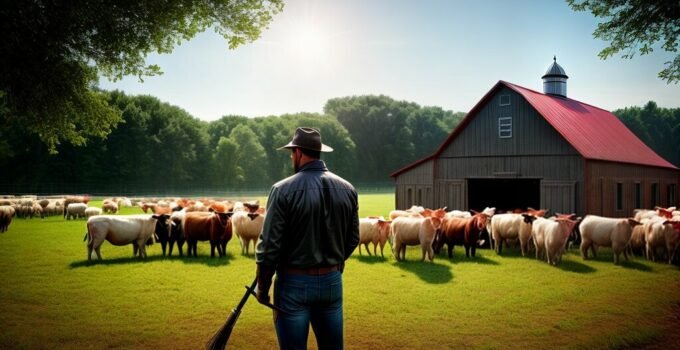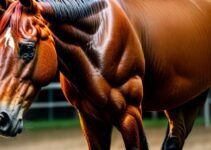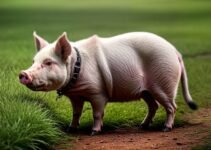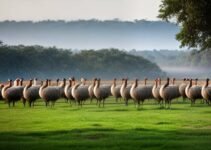When it comes to farming with animals, there are many economic considerations that farmers must take into account. From initial investment to ongoing expenses, there are many factors that can impact profitability and sustainability.
In this article, we will explore the key insights into the economic considerations of farming with animals. We will discuss the financial analysis of animal farming, livestock farming expenses, conducting a cost-benefit analysis, assessing profitability, the economic impact of animal agriculture, financial implications, and more.
Key Takeaways:
Farmers must conduct a thorough financial analysis of animal farming to understand costs and revenue streams.
Livestock farming expenses can include purchasing and maintaining animals, housing, feeding, and healthcare.
Conducting a cost-benefit analysis is crucial to maximizing profitability in animal agriculture.
Market demand, pricing, competition, and operational efficiency all impact the profitability of raising animals on a farm.
Animal farming can contribute to local economies, job creation, and overall agricultural productivity.
There are both risks and rewards associated with animal farming, including financial stability, diversification, and long-term sustainability.
Technology and government regulations play a significant role in optimizing profitability and efficiency in animal agriculture.
Farmers must assess their resources and market demand to evaluate the economic feasibility of animal husbandry practices.
Niche markets, value-added products, sustainability practices, and potential obstacles all present opportunities and challenges in farming with animals.
Understanding the Financial Analysis of Animal Farming
Animal farming is a significant investment that requires careful financial planning. By analyzing the costs and revenues associated with raising animals, farmers can determine the profitability and feasibility of their farming operations.
Factors Affecting Animal Farming Economics
Several factors affect the economics of animal farming, including:
- The type and number of animals raised on the farm
- The cost of animal feed and other inputs
- The cost of equipment and facilities
- The cost of veterinary care and other healthcare expenses
- The price of animal products in the market
Understanding these factors and their impact on animal farming economics is crucial for farmers looking to optimize profitability.
Financial Analysis of Animal Farming
Conducting a thorough financial analysis is essential before starting an animal farming operation. This analysis should include a detailed breakdown of all costs, such as:
| Cost Category | Description |
|---|---|
| Initial Investment | The upfront cost of purchasing equipment and animals. |
| Feed and Supplies | The cost of animal feed and other supplies such as bedding, cleaning materials, and medications. |
| Veterinary Expenses | The cost of veterinary care and other healthcare expenses. |
| Labor Costs | The cost of paying employees or hiring contractors to perform work on the farm. |
| Marketing and Sales | The cost of advertising and promoting animal products, as well as the revenue generated from selling animal products such as meat, milk, and eggs. |
Once the costs have been identified, farmers can calculate the break-even point for their animal farming operation to determine profitability.
Revenue Streams for Animal Farming
Animal farming revenue streams can come from the sales of various animal-related products. These can include:
- Sales of meat, such as beef, chicken, and pork
- Sales of eggs, such as chicken and duck eggs
- Sales of milk, such as cow and goat milk
- Sales of wool, fur, and other animal by-products
By diversifying revenue streams, farmers can optimize profits and create sustainable animal farming operations.
Analyzing Livestock Farming Expenses
When it comes to livestock farming, expenses can quickly add up and impact profits. To make informed decisions about the economic feasibility of raising animals on a farm, it’s critical to understand the various expenses involved.
The following are some of the most significant expenses that farmers need to consider:
| Expense | Description |
|---|---|
| Purchasing animals | The cost of buying livestock or other animals to raise, including shipping and handling fees. |
| Housing | The cost of providing shelter for the animals, including construction, repairs, and maintenance. |
| Feeding | The cost of providing food and water for the animals, including purchasing feed, supplements, and other nutritional products. |
| Healthcare | The cost of veterinary care, vaccinations, medications, and other healthcare-related expenses. |
| Equipment | The cost of purchasing and maintaining equipment necessary for animal farming, including tractors, plows, and other machinery. |
By understanding these expenses, farmers can make informed decisions about whether to invest in livestock farming and what steps to take to optimize profitability.
It’s worth noting that the cost of livestock farming can vary greatly depending on the type of animal and the scale of the operation. For example, raising chickens on a small-scale operation may require less initial investment and lower ongoing costs than raising cattle on a large-scale farm.
Ultimately, farmers need to carefully consider their resources and market demand before making decisions about livestock farming. Analyzing expenses is a critical step in this process, as it can provide insights into the potential challenges and opportunities associated with this type of agriculture.
Conducting a Cost-Benefit Analysis of Animal Agriculture
When considering raising animals on a farm, it’s important to conduct a cost-benefit analysis. This involves evaluating both the costs and benefits associated with animal agriculture to determine whether it is a financially viable endeavor. Here are some key steps to guide this analysis:
- Outline all costs: The first step is to identify and outline all the costs involved in raising animals, including initial investments, feed, housing, healthcare, and transportation.
- Estimate revenue streams: Next, estimate the potential revenue streams from selling animal products such as meat, milk, eggs, and other products. Consider market demand, pricing, and competition in these calculations.
- Calculate the breakeven point: Using the outlined cost and estimates of revenue streams, calculate the point at which the business will break even. This is a crucial step as it indicates how much revenue is required to cover all costs associated with raising animals on the farm.
- Evaluate profitability: With the breakeven point calculated, the next step is to evaluate profitability. Determine the gross profit margin, net profit margin, and return on investment (ROI) to assess the profitability of the animal farming operation.
- Optimize profitability: Finally, once the profitability of animal agriculture has been assessed, farmers can take steps to optimize profitability. This may include reducing costs, increasing revenue streams, implementing sustainable and efficient practices, and exploring niche markets.
By conducting a cost-benefit analysis, farmers can determine whether animal agriculture is a financially viable and sustainable option for their farm. This information can guide decision-making to ensure long-term profitability and success in the industry.
Assessing the Profitability of Raising Animals on a Farm
Raising animals can be a profitable venture for farmers, but profitability depends on a range of factors such as market demand, pricing, competition, and operational efficiency. By considering these factors, farmers can determine the viability of their animal farming endeavors.
Market demand is a crucial factor to consider when assessing the profitability of animal farming. Farmers should research the demand for the animals they plan to raise and the related products they can sell. If there is a high demand for those products in the local market, farmers can potentially earn higher profits.
Pricing is another essential factor that influences the profitability of animal farming. Farmers must set prices that are competitive enough to attract customers, while also covering their expenses and making a profit.
Competition is another crucial element to consider when evaluating the profitability of animal farming. Farmers must research their competitors’ products and prices to determine how they can differentiate their offerings. By offering unique products or services, they can potentially attract more customers and earn higher profits.
Operational efficiency is a critical factor that directly affects the profitability of animal farming. Farmers should aim to optimize their operations by increasing efficiency and reducing costs. For example, they can use technology to automate tasks and reduce labor costs, or implement sustainable practices to reduce their environmental footprint and lower expenses.
To sum up, assessing the profitability of raising animals on a farm requires careful consideration of market demand, pricing, competition, and operational efficiency. Farmers who research these factors and optimize their operations accordingly can potentially earn higher profits and build a sustainable animal farming business.
Understanding the Economic Impact of Livestock Farming
Livestock farming plays a significant role in the economy, providing jobs, income, and food products to communities across the United States. In addition to its economic benefits, animal agriculture also has environmental and social implications that are important to consider.
Contribution to Local Economies
Livestock farming contributes to the local economy by generating direct and indirect jobs, income, and tax revenue. According to a 2018 report by the American Farm Bureau Federation, the livestock sector supports over 1.6 million jobs and contributes $252 billion to the U.S. economy.
Animal farming also stimulates economic activity in related industries, such as transportation, processing, and retail. Moreover, many small-scale farmers rely on livestock as a source of income and a means of diversifying their operations.
Environmental and Social Implications
The impact of livestock farming on the environment and social fabric of communities is a complex issue. While animal agriculture can provide economic benefits, it can also contribute to greenhouse gas emissions, water pollution, and soil degradation. At the same time, it can foster community engagement, promote local food systems, and support ethical treatment of animals.
Farmers and policymakers must strive to balance these competing interests to ensure that animal agriculture is sustainable, both economically and environmentally. This may involve implementing innovative technologies, promoting sustainable practices, and developing regulations that balance economic and environmental considerations.
Exploring the Financial Implications of Animal Farming
Animal farming can have significant financial implications, both positive and negative. Farmers must carefully consider the risks and rewards associated with raising animals and weigh them against their available resources and market demand.
One potential benefit of animal farming is increased financial stability. Diversifying a farm’s income streams by adding animal production can help mitigate the risks of relying solely on crop yields. Additionally, raising animals can provide a steady source of income through the sale of meat, milk, eggs, and other animal-related products.
However, there are also potential risks to consider. Farmers may face challenges such as disease outbreaks, which can lead to significant financial losses. Climate change and market volatility can also impact the profitability of animal farming.
It’s crucial for farmers to conduct a thorough financial analysis before investing in animal farming. This includes evaluating the initial investment required, ongoing costs such as animal feed and veterinary care, and revenue streams from animal products.
Efficient operation of the farm is critical to optimizing profitability. Farmers can use technology such as precision feeding systems to reduce feed costs, or genetic selection to improve animal health and productivity. By improving efficiency, farmers can reduce expenses and increase profits.
It’s important to note the potential environmental and social impacts of animal farming as well. Sustainable farming practices can help mitigate negative effects on the environment while also benefiting the local community.
Overall, the financial implications of animal farming are complex and must be carefully evaluated. Farmers who take a strategic approach to investing in animal production and consider market demand, available resources, and sustainable practices will be best positioned to succeed financially.
Examining the Economic Aspects of Animal Agriculture
Animal agriculture is a complex industry that is influenced by a wide range of economic factors. Farmers must consider market trends, government regulations, subsidies, and the role of technology in optimizing profitability and efficiency. By understanding these aspects, they can make informed decisions about their farming practices.
Market Trends: The demand for animal products can be influenced by a variety of factors, such as changing consumer preferences, dietary trends, and economic conditions. Farmers must stay up-to-date with market trends to ensure that they are producing products that meet consumer demand.
| Government Regulations: | Subsidies: |
|---|---|
| The government regulates many aspects of animal agriculture, such as food safety, environmental impact, and animal welfare. Farmers must comply with these regulations to avoid fines and legal action. | The government offers subsidies to support animal agriculture, such as crop insurance, disaster relief, and conservation programs. Farmers can take advantage of these subsidies to reduce their costs and increase their profitability. |
Technology: Advances in technology can help farmers optimize their operations by improving efficiency, reducing costs, and increasing productivity. For example, precision farming techniques can help farmers use resources more efficiently, such as reducing water usage and fertilizer application.
Overall, the economic aspects of animal agriculture are critical to the success of the industry. By staying informed about market trends, complying with government regulations, taking advantage of subsidies, and utilizing technology, farmers can maximize their profitability and sustainability.
Evaluating the Economic Feasibility of Animal Husbandry
Animal husbandry requires a significant investment of time and money, and farmers must carefully consider the economic feasibility of raising animals on their farm. Several factors can impact the profitability of animal farming, including local market demand, input costs, and operational efficiency.
One key consideration is the availability of resources. Farmers must evaluate the suitability of their land for animal husbandry and assess whether they have access to adequate supplies of water and feed. Additionally, they must consider the costs of constructing and maintaining animal housing and purchasing necessary equipment.
Market demand is also an essential factor in determining the economic feasibility of animal farming. Farmers must determine whether there is a market for the animals they plan to raise and whether they can sell their products at a competitive price. They may need to consider niche markets or value-added products to differentiate themselves from competitors.
Another essential consideration is financial stability. Farmers must assess their ability to manage risk and weather economic downturns. They may need to secure financing to cover initial expenses and ensure they have sufficient cash flow to cover ongoing expenses.
Finally, farmers must consider the long-term sustainability of their animal farming practices. They must evaluate the environmental impact of their operations and consider adopting sustainable practices to minimize their carbon footprint and improve the long-term viability of their business.
Opportunities and Challenges in Farming with Animals
Farming with animals offers numerous opportunities for farmers to diversify their operations and increase profitability. However, it also comes with its own set of challenges.
Opportunities
One opportunity in farming with animals is tapping into niche markets. Consumers are increasingly interested in locally-produced, organic, and sustainably-raised animal products, such as grass-fed beef, free-range chicken eggs, and heritage pork. By identifying and supplying these markets, farmers can often command higher prices for their products.
Another opportunity is creating value-added products, such as artisanal cheeses, sausages, and other specialty items. Farmers can use their animal products to create unique and high-quality products that stand out in the marketplace.
Sustainability is also becoming an important consideration in farming with animals. Practices such as rotational grazing and using animal manure as fertilizer can improve soil health and reduce reliance on external inputs. By adopting sustainable practices, farmers can also market their products to environmentally-conscious consumers.
Challenges
Disease outbreaks are a major challenge in animal farming. A single outbreak can devastate a farmer’s operations and lead to significant financial losses. Farmers need to be vigilant in identifying and preventing disease outbreaks through proper sanitation and animal care.
Climate change also poses challenges for animal farmers. Extreme weather events, droughts, and floods can disrupt feed supplies and make it difficult to maintain animal health. Farmers need to be prepared to adapt to changing weather patterns and invest in climate-resilient infrastructure.
Market volatility is another challenge in animal farming. Prices for animal products can fluctuate depending on supply and demand, and farmers need to be able to adjust their operations accordingly. Diversification, value-added products, and finding stable markets can help mitigate the risks associated with market volatility.
Despite these challenges, farming with animals can be a profitable and rewarding endeavor. By staying informed about industry trends, adopting sustainable practices, and identifying niche markets, farmers can optimize their operations and contribute to the overall health of their communities and the environment.
Conclusion
As the article has demonstrated, there are numerous economic considerations to take into account when farming with animals. Understanding the financial analysis of animal farming is crucial to identifying the costs involved and potential revenue streams. By analyzing livestock farming expenses, farmers can gain a clearer picture of the resources required to raise animals on their farms.
Conducting a cost-benefit analysis of animal agriculture provides key insights into how to maximize profitability. Farmers must also assess the profitability of raising animals on their farms by considering market demand, pricing, competition, and operation efficiency. Understanding the economic impact of livestock farming is important, not just for individual farmers, but for local economies and agricultural productivity as a whole.
Exploring the financial implications of animal farming, as well as the broader economic aspects of animal agriculture, is vital for optimizing profitability and ensuring long-term sustainability. Evaluating the economic feasibility of animal husbandry practices helps farmers make informed decisions about investment in raising animals.
Despite the challenges that arise when farming with animals, there are also opportunities to explore niche markets, value-added products, and sustainability practices. By remaining aware of potential obstacles, such as disease outbreaks, climate change, and market volatility, farmers can take proactive measures to mitigate risks and maximize profits.
Overall, it is clear that considering the economic aspects of farming with animals is vital for the success and longevity of this type of agriculture. Farmers who take the time to conduct thorough financial analysis, assess their resources, and explore opportunities for optimization are better equipped to build profitable and sustainable animal farms.
FAQ
Q: What will Section 2 discuss?
A: Section 2 will delve into the financial analysis of animal farming, exploring costs and revenue streams.
Q: What topics will Section 3 cover?
A: Section 3 will focus specifically on the expenses associated with livestock farming, including purchasing, housing, and healthcare.
Q: What will be discussed in Section 4?
A: Section 4 will outline the importance of conducting a cost-benefit analysis for animal agriculture and provide insights on maximizing profitability.
Q: What factors will Section 5 explore?
A: Section 5 will discuss market demand, pricing, competition, and operation efficiency, all impacting the profitability of raising animals on a farm.
Q: What will Section 6 examine?
A: Section 6 will analyze the broader economic impact of livestock farming, including contributions to local economies and job creation.
Q: What will be covered in Section 7?
A: Section 7 will delve into the financial implications of animal farming, discussing risks, rewards, and long-term sustainability.
Q: What topics will be discussed in Section 8?
A: Section 8 will provide an overview of economic aspects of animal agriculture, including market trends, regulations, and technology.
Q: What will Section 9 focus on?
A: Section 9 will specifically evaluate the economic feasibility of animal husbandry practices, considering factors such as resource availability and market demand.
Q: What will Section 10 highlight?
A: Section 10 will discuss opportunities and challenges that arise when farming with animals, including niche markets and sustainability practices.



